
Pierre-Auguste Renoir was a French artist who was a leading painter in the development of the Impressionist style. As a celebrator of beauty and especially feminine sensuality, it has been said that "Renoir is the final representative of a tradition which runs directly from Rubens to Watteau."
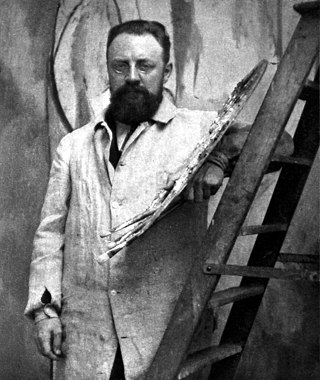
Henri Émile Benoît Matisse was a French visual artist, known for both his use of colour and his fluid and original draughtsmanship. He was a draughtsman, printmaker, and sculptor, but is known primarily as a painter. Matisse is commonly regarded, along with Pablo Picasso, as one of the artists who best helped to define the revolutionary developments in the visual arts throughout the opening decades of the twentieth century, responsible for significant developments in painting and sculpture.

Suzanne Valadon was a French painter who was born Marie-Clémentine Valadon at Bessines-sur-Gartempe, Haute-Vienne, France. In 1894, Valadon became the first woman painter admitted to the Société Nationale des Beaux-Arts. She was also the mother of painter Maurice Utrillo.

Luncheon of the Boating Party French: Le Déjeuner des canotiers is an 1881 painting by French impressionist Pierre-Auguste Renoir. Included in the Salon in 1882, it was identified as the best painting in the show by three critics. It was purchased from the artist by the dealer-patron Paul Durand-Ruel and bought in 1923 from his son by industrialist Duncan Phillips, who spent a decade in pursuit of the work. It is now in The Phillips Collection in Washington, D.C. It shows a richness of form, a fluidity of brush stroke, and a flickering light.
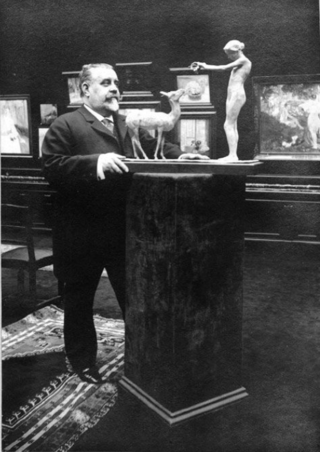
Georges Petit was a French art dealer, a key figure in the Paris art world and an important promoter and cultivator of Impressionist artists.
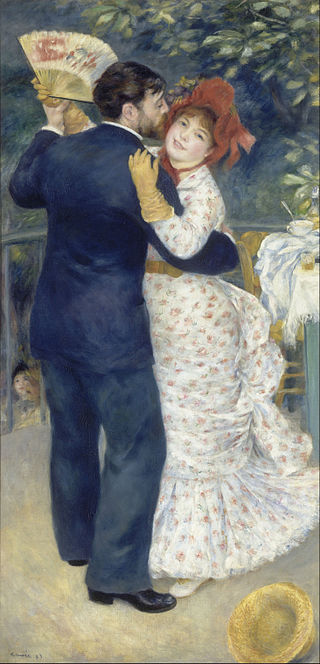
Dance in the Country is an 1883 oil painting by French artist Pierre-Auguste Renoir. It is currently kept at the Musée d'Orsay in Paris.
Albert André was a French Post-Impressionist figurative painter. He produced portraits of Pierre-Auguste Renoir, his closest friend, and Claude Monet.
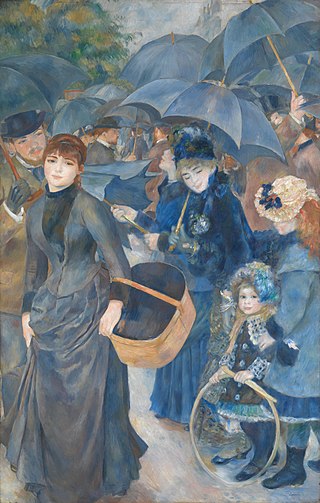
The Umbrellas is an oil-on-canvas painting by Pierre-Auguste Renoir, painted in two phases in the 1880s. It is owned by the National Gallery in London as part of the Lane Bequest but is displayed alternately in London and at the Dublin City Gallery The Hugh Lane. From May 2013 to 2019, it returned to Dublin for a six-year period. It is now in the National Gallery London.
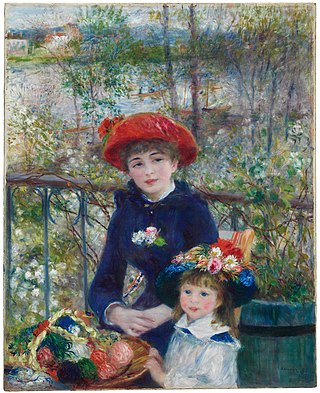
Two Sisters or On the Terrace is an 1881 oil-on-canvas painting by French artist Pierre-Auguste Renoir in the collection of the Art Institute of Chicago. The dimensions of the painting are 100.5 cm × 81 cm. The title Two Sisters was given to the painting by Renoir, and the title On the Terrace by its first owner Paul Durand-Ruel.

La Parisienne is an oil painting by the French artist Pierre-Auguste Renoir, completed in 1874 and now displayed at the National Museum Cardiff. The work, which was one of seven presented by Renoir at the First Impressionist Exhibition in 1874, is often referred to as The Blue Lady(French: La Dame en Bleu) and is one of the centre-pieces of the National Museum's art collection.

Dance at Bougival is an 1883 oil-on-canvas painting by the French artist Pierre-Auguste Renoir, currently in the collection of the Museum of Fine Arts in Boston, Massachusetts, United States. Described as "one of the museum's most beloved works", it is one of three in a collection commissioned by Paul Durand-Ruel. It depicts a scene in the French village of Bougival, about 15 km from the center of Paris, a site utilized by many Impressionists besides Renoir including Claude Monet, Alfred Sisley, and Berthe Morisot.

Parisian Women in Algerian Costume (The Harem), sometimes known as Interior of a Harem in Montmartre (Parisian Women Dressed in Algerian costumes), is a painting by Pierre-Auguste Renoir, completed 1872, which Renoir created in homage to Eugène Delacroix's Women of Algiers in their Apartment (1834, Louvre). It was rejected for entry to the 1872 Paris Salon, disliked by the artist and eventually sold for a small sum as part of a larger lot. It is now in the National Museum of Western Art, Tokyo.

La Promenade is an oil on canvas, early Impressionist painting by the French artist Pierre-Auguste Renoir, created in 1870. The work depicts a young couple on an excursion outside of the city, walking on a path through a woodland. Influenced by the rococo revival style during the Second Empire, Renoir's La Promenade reflects the older style and themes of eighteenth-century artists like Jean-Honoré Fragonard and Jean-Antoine Watteau. The work also shows the influence of Claude Monet on Renoir's new approach to painting.
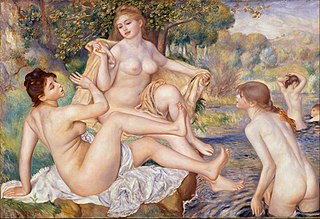
Les Grandes Baigneuses, or The Large Bathers, is a painting by Pierre-Auguste Renoir made between 1884 and 1887. The painting is in the Philadelphia Museum of Art, in Philadelphia.

Woman with Parakeet is a painting by Pierre-Auguste Renoir created in 1871. It is in the holdings of the Solomon R. Guggenheim Museum in New York as part of the Thannhauser Collection. The painting portrays model Lise Tréhot, who posed for Renoir in over twenty paintings during the years 1866 to 1872.
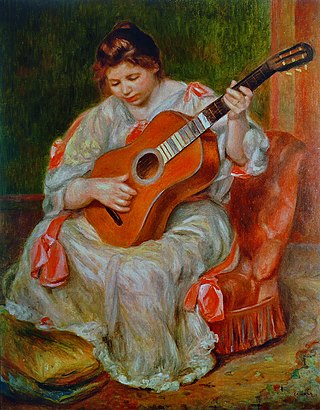
Woman Playing a Guitar is an 1897 painting by Pierre-Auguste Renoir representing his late work period (1892–1919). It is now in the Museum of Fine Arts of Lyon, which bought it in 1901.

Diana is a painting from 1867 by the French painter Pierre-Auguste Renoir. It is thought to depict the painter's lover Lise Tréhot as the Roman goddess Diana, although the exact identification of the model in the painting is disputed by art historians.

Portrait of Ambroise Vollard is an oil-on-canvas painting by Pablo Picasso, which he painted in 1910. It is now housed in the Pushkin Museum in Moscow. The painting is a representation of the influential art dealer Ambroise Vollard, who played an important role in Picasso's early career as an artist. It is painted in the style of Analytical Cubism, which Picasso pioneered.
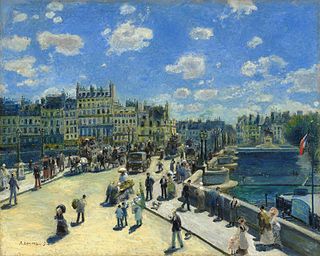
Le Pont-Neuf is an 1872 oil-on-canvas painting by the French artist Pierre-Auguste Renoir. It is held by the National Gallery of Art in Washington, D.C.


















